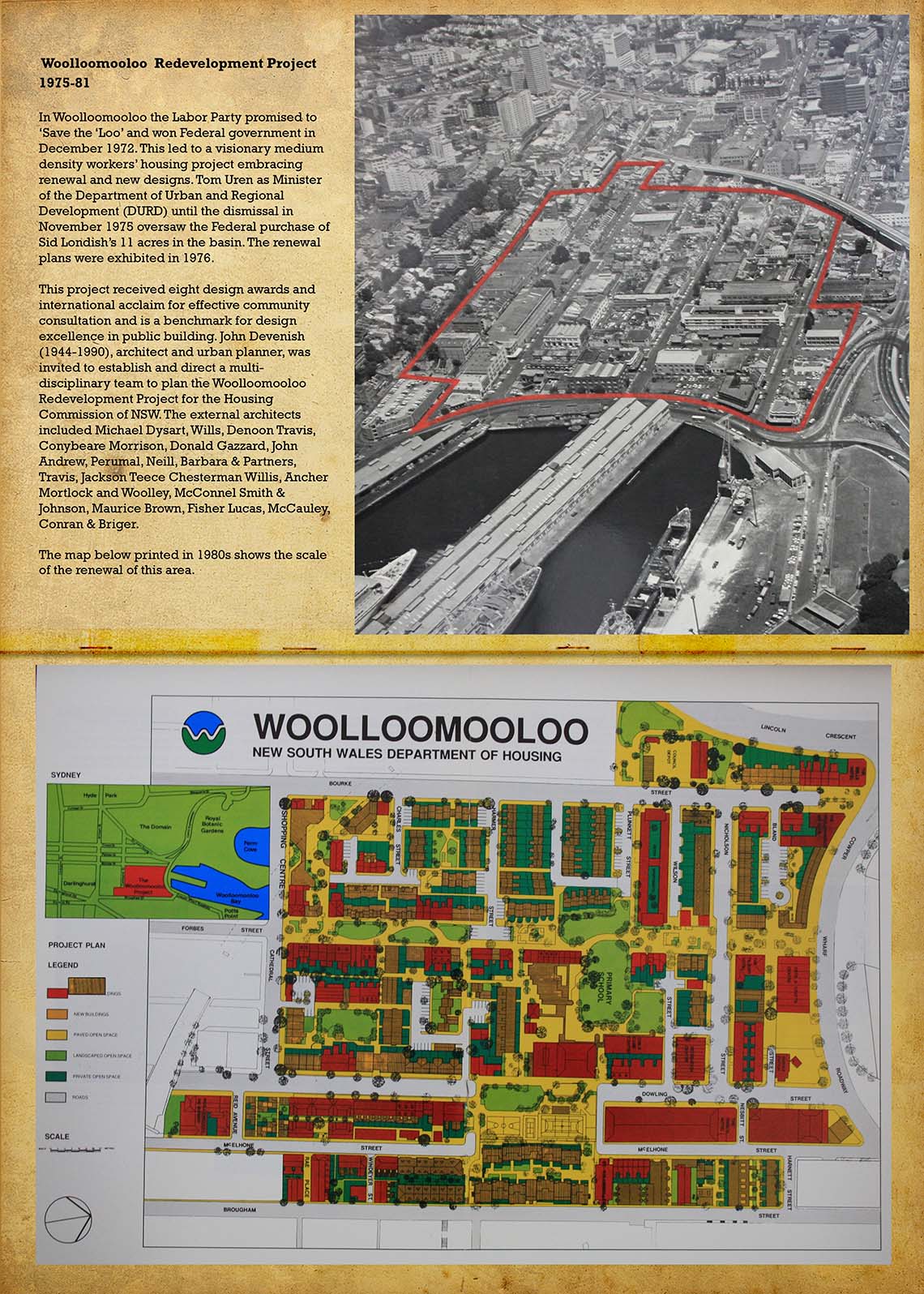Green Bans Architecture, Housing & Planning
Heritage Laws Come into Being
The election of the Whitlam Government in 1973 was, in part, on a platform of protecting the national estate, incorporating built and natural heritage. These policies included curtailing urban development impacts on historic areas as well as maintaining green belts.Whitlam’s minister for cities, Tom Uren, supported the green bans. He wanted Jack Mundey to join the Inquiry into the National Estate, but the NSW Askin government refused to support the inquiry if Mundey was involved. The federal government’s National Estate Report (1974) nevertheless recorded: Is it any wonder that ‘green bans’ and other forms of direct action are not being resorted to more and more frequently? Governments must act to meet these demands, and act decisively, for they have delayed too long already.
The green bans were part of a decisive shift in Australian urbanism. Conservation became a mainstream planning, architectural and policy concern. The federal government passed heritage legislation in 1975, followed by every state over the next 16 years or so. Victoria was first in 1974.
The green bans remained in place as the urban development pipeline collapsed amid the economic shocks of the mid-1970s oil crisis. By the time construction picked up in the 1980s, tens of thousands of heritage places had potential statutory protections. A new specialist industry of conservation architects, planners and policymakers had emerged from the ranks of heritage activists.
Australian Urbanism: Let's Live in Woolloomooloo
By 1974 the 'BLF' or Builder's Labourer's Federation (NSW) had placed Green Bans over construction works that threatened the Centennial Parklands, Woolloomooloo, the Royal Botanic Gardens and The Rocks. Through these bans the union's membership expressed their commitment to building socially "useful buildings such as Kindergartens, homes for the aged, hospitals and housing for ordinary people." (1972 Jack Mundey, Letter to the Sydney Morning Herald in 1972.)The Rocks and Millers Point the Green Ban was resolved when the Sydney Cove Redevelopment Authority agreed a compromise where some development could go ahead on the proviso that some residents were rehoused in quality accommodation but at low, affordable rents. (2015 National Trust Nomination to NSW Heritage Register.)
Victoria Street heritage was saved but lost to low-income housing. (The Victoria Point Development was only 7-storeys not the proposed three 45-storey towers set on 5-storey podiums). The great victory for low-income housing was the Woolloomooloo Housing Renewal Project. In 1975 Tom Uren, Federal Minister for Urban and Regional Development in the Whitlam Government said, “I’ve been training all my life.” Green bans revived the idea of civic memorials and Margel Hinder’s bronze water sculpture “Aphrodite” splashed joyfully at the dedication of Denis Winston Place.
Denis Winston the first Professor of Town Planning at Sydney University, regarded human scale, diversity in housing, landscaped spaces and sculpture as essential to the pleasures of urban living. He would have delighted in the variety of the housing enclosing the Woolloomooloo Estate: side-by-side stand the new and the rehabilitated. (Text adapted from Sir Hermann David Black, from Opening Invitation of Denis Winston Place, Housing Commission of NSW and the Denis Winston Memorial Committee of the Planning Research Centre, University of Sydney, October 1981.)
To commemorate the building of Woolloomooloo Estate, the architecture faculty raised funds for a memorial sculpture by Margel Hinder to stand in Denis Winston square, designed by Mike Ewings. In 2013 the square was flattened and “anti-sitting” structures installed. Locals are campaigning for a joint council / Housing initiative to re-start the Margel Hinder fountain. Much of Sydney's innovative architecture in the late 1970s is a testimonial to community and union protest for mixed-communities, heritage and better housing.
Woolloomooloo Renewal Project Team (1975-81)
John Devenish (1944-1990), architect and urban planner, was invited to establish and direct a multi-disciplinary team to plan the Woolloomooloo Redevelopment Project for the Housing Commission of NSW. This project received eight design awards and international acclaim for effective community consultation and is a benchmark for design excellence in public building.The external architects included Michael Dysart, Wills, Denoon Travis, Conybeare Morrison, Donald Gazzard, John Andrew, Perumal, Neill, Barbara & Partners, Travis, Jackson Teece Chesterman Willis, Ancher Mortlock and Woolley, McConnel Smith & Johnson, Maurice Brown, Fisher Lucas, McCauley, Conran & Briger.
John Devenish (1944-1990)
Architect and urban planner, was invited to establish and direct a multi-disciplinary team to plan the Woolloomooloo Redevelopment Project for the Housing Commission of NSW. This project received eight design awards and international acclaim for effective community consultation and is a benchmark for design excellence in public building. See: NSW RAIA Chapter: John Devenish, residential design rehabilitation and infill, NSW Building Society Housing Awards, 1982, no 12. Awarded "With respect to its context but without a slavish copying of its neighbours."Michael Dysart
Designed Housing Commission Townhouses, Woolloomooloo, NSW (1977)Michael Dysart is an important architect of the second half of the twentieth century in Australia and a leading practitioner of the late twentieth century Sydney regional style of architecture. He played an important role in the development of public buildings in NSW, notably educational buildings, and affordable housing, specifically in the development of modern architect designed project homes and co-operative communal housing in NSW and the ACT.
Born in 1934, Dysart won one of the small number of NSW Government Architect traineeships in 1955 and on graduating from the University of Sydney in 1958 he was the last to join of the four key trainees who became part of the design office working under Harry Rembert. The other members of the design office at the Government Architects were Peter Weber, who later became the Government Architect, Ken Woolley, who later became a partner at Ancher Mortlock Murray and Woolley, and Peter Hall, who later combined with others to take over the Sydney Opera House from Jorn Utzon. Dysart remained with the NSW Department of Public Works until 1969. Dysart joined with Peter Bell to form the practice of Michael Dysart & Partners in 1970. Dysart himself, or in association, has received a number of major architectural awards including: RAIA NSW Blackett Award, 1965, for the Taree Technical College.
Michael Ewings
Landscape architect who designed the landscapes of the Woolloomooloo Estate as ‘landscape masterplanning’. Their aim was to create a fully integrated development with more open space, expressing the trend of dissolving the streets in an attempt to blend green spaces with other functional and circulation requirements. Ewings established Sydney consultants Environmental Landscapes PL in 1977. He worked with architect Phillip Cox (one of the commissioned Woolloomooloo architects) on the Yulara Tourist Village at Uluru in Central Australia.NSW Government Architects
The NSW Government Architects were responsible for designing public schools and public housing, amongst other buildings. During the period from 1947 to 1972 the high school student numbers in NSW grew from around 80,000 to 280,000. The High School Programme (within the NSW Government Architects office) was a major thrust as was public housing.Denis Winston
First professor of Town Planning at Sydney University is honoured with a square in Woolloomooloo opened in 1981. Denis Winston Place: designed by Environmental Landscapes PL and planted with Jacarandas, Robineas and Peppercorns, “an oasis of green around a pair of existing trees”. It honours Professor Denis Winston (1908-1980) the first chair of town and country planning in Australia. On 21 October 1981, the Chancellor of Sydney University also opened Margel Hinder’s bronze sculpture, named Denis Winston Library and launched a Memorial Appeal in his honour.Denis Winston regarded human scale, diversity in housing, landscaped spaces and sculpture as essential to the pleasures of urban living. … He would have delighted in the variety of the housing enclosing the Place, new on two side, rehabilitated, though a century old, on the other two, with the elderly emerging form their houses to mix with the children form the others. (Text by Sir Hermann David Black, from Opening Invitation of Denis Winston Place, Housing Commission of NSW and the Denis Winston Memorial Committee of the Planning Research Centre, University of Sydney, October 1981.)
They raised funds for a memorial sculpture by Margel Hinder to stand in the square, designed by Mike Ewings. The square was recently flattened and “anti-sitting” structures installed.
Winston, Arthur Denis (1908–1980) by Robert Freestone: http://adb.anu.edu.au/biography/winston-arthur-denis-12055
A visual reflection of the life and time of Denis Winston. Talk by Stacey Miers: http://sydney.edu.au/festival-urbanism/events/2015/audio2/DenisWinston.mp3
Resident action plans
In many cases, green bans were placed at the request of residents who were concerned for the future development of their area. They were aggrieved at the lack of consultation from both developers and the government, who they felt did not have the best interests of the community in mind. As such, they devised resident action plans, or “Peoples’ Plans”, which outlined their primary goals for the future planning of their community. Often these plans consisted of a list of conditions, such as maintaining low-rise living and affordability for low-income earners. The BLF advocated on behalf of residents, refusing to lift bans until local councils and developers devised development plans which fit within the guidelines proposed by residents. Green bans ensured their continued involvement in the future planning of their cities.
Resident action groups fought for meaningful participation in the planning process. They often researched and drafted substantial action plans that put forward key ideas for their locale. The Glebe Society, for example, was the initiative of Bernard Smith, professor of Fine Arts at the University of Sydney, and his wife, Kate, and founded in 1969. The approach was to ensure that adequate thought and planning went into new projects and to preserve and conserve what is good in the already existing buildings and places of historic interest. The right to a citizen voice was included in the key legislative outcomes of the green bans – the Heritage Act and the EP&A Act but have been eroded to meaningless “have your say” sessions or e-portals. Key 1970s examples of these plans include those by the Glebe and Paddington Societies and the Peoples Plan for The Rocks. These plans were often facilitated by an in-house architect or planner. In Victoria Street they put forward a “Little Green Book. The Facts on the Green Bans”. (Anne Summers et al.) Most led to an area’s status as a Conservation Area and listings for individual heritage items. Many local councils enshrined participatory committees in their structure, North Sydney’s precinct committees being an example.
See: The Rocks, Darlinghurst & Surry Hills, Newcastle (East End), South Sydney & Waterloo, Woolloomooloo, and Kings Cross
The Rocks and Sirius Architecture
Tao (Theodore) Gofers
Designed the Sirius Building at The Rocks. Built by the Sydney Cove Redevelopment Authority, 1978-1979.The building was also well known for a sign announcing 'One Way! Jesus' that featured in the window of Unit 74 facing the Bridge for more than 15 years. The creator, an elderly resident, was among those forcibly dispersed by the NSW Liberal Government in 2015.
Sirius is a 79-apartment residential building complex consists of repetitive geometric (cubic) elements stacked on top of each other to give a step-like terrace effect rising from under five storeys for much of the northern sections and part of the southern end, to eleven storeys in a high-rise block towards the south. The profile of the apartment building is a landmark in the Central Sydney Precinct. It was originally intended to have a white finish to echo the Opera House but, due to budget constraints, the building remained in grey, off-the-form concrete. At the time of construction, one of the main complaints was that the building rose above the level of the Bridge's roadway. The general form is inspired in part by Moshe Safgdie's Habitat '67 residential complex in Montreal, originally built for Expo '67. Another Housing Commission apartment building designed by Gofers and built as a prototype for the Sirius Apartment Building, was built at 1A Ritchie Street, Sans Souci, on the site of a former trolley-bus, then bus, depot.
The majority of the apartments open onto gardens on the roofs of lower apartments, while there is also a communal garden on the 8th floor and ground floor courtyards. Hanging garden effects soften the appearance of the concrete. Inside, the main foyer has a slatted 'waving' timber ceiling and there are three-dimensional wood sculptures designed by the architect, Tao Gofers, based on European cave art figures. There are two community lounges, both with marvelous views, as well as service rooms and on-site parking. The foyer also accommodates a distress call panel indicating one or other of the aged care units should the resident press the alarm. This no longer works but is an important expression of the designer's attention to the requirements of elderly residents.
The Institute of Architects (NSW) has been campaigning for a decade for State Heritage Listing for Sirius. Brutalist buildings are a potent symbol of their time: The carefully modulated block, inspired by Moshe Safdie’s Habitat 67 in Montreal, Canada, contrasts with the public housing complex Greenway, on the other side of the Sydney Harbour Bridge, designed by Morrow and Gordon and built during 1948–1953. See: Architecture Bulletin, Mar-Apr 2012, Brutalism: a heritage issue at http://architecture.com.au/docs/default-source/nsw-journal/march-april.pdf?sfvrsn=0
This recommendation to list Sirius is opposed by the new lessee Department of Community Services. The foyer still houses the 40-strong team of 'relocation officers' evicting over 500 mostly elderly residents from the Sirius and Millers Point communities.
Stewart Sydes (1926-2018)
Joined construction company Monier and rose through the ranks. Under Premier Bob Heffron, the number of public schools was expanded with Monier doing much of the construction. In 1964, Sydes partnered with two Hawaiian-based companies Amelco PL ad VHY Pty Ltd Hawaii to form his own building company VHY Pty Ltd. In Australia, the NSW Housing Commission was their main client including constructing the Sirius building in the Rocks. While working on Sirius, Sydes met Builders Labourers' Federation Secretary Jack Mundey and the two reached an agreement that VHY employ women builders' labourers.Bibliography
NSW RAIA Chapter John Devenish, residential design rehabilitation and infill, NSW Building Society Housing Awards, 1982, no 12. Awarded "With respect to its context but without a slavish copying of its neighbours."NSW RAIA Chapter Bulletin, 1982, no 12, p 1, 6, 7: 'Urban Consolidation' by Jean Rice, a draft State Environment Planning Policy and Medium Density Public Housing for Comment; to set a standard of height, density, landscaped area and private open space. Other objectives include reduce house prices, public sector costs, increase housing variety etc.
NSW RAIA Chapter Bulletin, 1982, no 11, p15. From Chris Johnson, president: "There will be no radical shift to street marches, demonstrations and burning bad buildings. There will however be an attitudinal shift away from establishment and big business towards the community and quality of design."
NSW RAIA Chapter Bulletin, 1982, no 10, p16: Plunkett Public School re-located into Woolloomoollo is part of the plan for revival of a derelict area.
NSW RAIA Chapter Bulletin, 1982, no 6: Interview with Jack Mundey by Dinah Fisher. Mundey emphasises the importance of social responsibility and urban environment for example priority to public transport improvement over car parks.
NSW RAIA Chapter Bulletin,, 1982, no 4, p1 and 6: Joan Slottboom, 'Rural Bank 1935-198?' Summary: The NSW Chapter of the RAIA and Heritage Council support the preservation of the Rural Bank Martin Place.
NSW RAIA Chapter Bulletin, 1982, no 3, p46: Council reports resolutions against demolition of Rural Bank Martin Place including public meeting on 25 February and formal submissions to City Council to back up National Trust submissions.
NSW RAIA Chapter Bulletin, John Devenish, NSW Permanent Building Society, Awards, vol.38 (1981), no.6, p.15. Third place Multiple Dwellings.
NSW RAIA Chapter Bulletin, Merit Award, category 3 Multiple Housing, 1981: vol.38 (1981), no.10, p.11. For attached houses Forbes St Woolloomooloo, Allan Jack and Cottier; Housing Commission of NSW, John Devenish, Forbes and Nicholson Sts.
NSW RAIA Chapter Bulletin, Woolloomooloo development, RAIA review and position, vol.33 (1976), no.7, p.6-7 Summary and conclusion of the submission to the House Commission of NSW on the exhibition of schematic designs for the Woolloomooloo basin held during March. More considerations should given to the project such as more research should be carried out to determine the optimum population for the area, the diversity of use, relationship with the harvour, privately-owned dwellings, car parking, planting programmes, development of massing or envelope controls, control of colour and materials to ensure a cohesive and integrated development…etc.
NSW RAIA Chapter Bulletin, Woolloomooloo redevelopment, NSW RAIA committee formed, vol.30 (1974) no.8, p.4 New Task, "the Central Urban Committee is undertaking a reappraisal of Woolloomooloo redevelopment and would welcome assistance from members in the form of comments or suggestions."
NSW RAIA Chapter Bulletin, Woolloomooloo redevelopment, NSW RAIA position, vol.29 (1973) no.1, p.4, Woolloomooloo redevelopment attracted wide comment and the statement combined the general views expressed in two reports compiled by the central urban committee.
NSW RAIA Chapter Bulletin, Council Decisions, 1971, no.7, p.4-5, the Chapter supported these fright for the "Kelly's Bush" to be "Open Space Recreation" and to be used for residential subdivision.
NSW RAIA Chapter Bulletin, Victoria Street, NSW RAIA support for preservation, vol.27, 1971, no.12, p.1Council Decisions: "The President write to the Lord Mayor of Sydney urging an Action Plan for the preservation of Victoria Street and Challis Avenue, Kings Cross in their present form."
Rocks Peoples Plan Committee, A People's Plan for the Rocks, Sydney, 1972.



